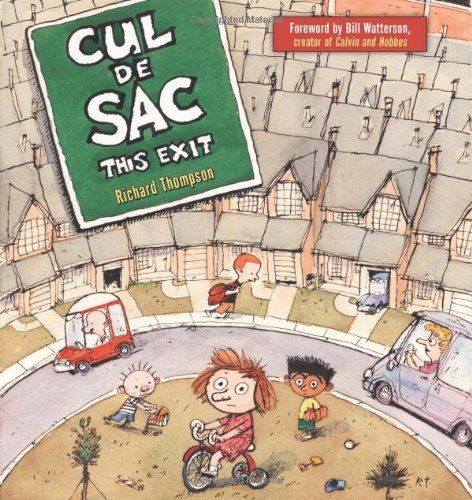
Cul De Sac This Exit
"One of the five best features in any newspaper, period." --The Comics Reporter "A much-needed jolt of energy to the daily newspaper. We have a real talent here." --Bill Waterson, Calvin and Hobbes "One of the few strips around where nearly every individual panel is stand-alone delight." --The Onion "...it really seems like the inheritor of 'Calvin and Hobbes.'" --Art Spiegelman "I can't say enough in his favor, so much is my admiration for his work." --Pat Oliphant 2 National Cartoonist Society "Best Comic Strip" nominations in 2 years of existence. "I thought the best newspaper comic strips were long gone, and I've never been happier to be wrong. Richard Thompson's Cul de Sac has it all--intelligence, gentle humor, a delightful way with words, and, most surprising of all, wonderful, wonderful drawings. Cul de Sac's whimsical take on the world and playful sense of language somehow gets funnier the more times you read it. Four-year-old Alice and her Blisshaven Preschool classmates will ring true to any parent. Doing projects in a cloud of glue and glitter, the little kids manage to reinterpret an otherwise incomprehensible world via their meandering, nonstop chatter. But I think my favorite character is Alice's older brother, Petey. A haunted, controlling milquetoast, he's surely one of the most neurotic kids to appear in comics. These children and their struggles are presented affectionately, and one of the things I like best about Cul de Sac is its natural warmth. Cul de Sac avoids both mawkishness and cynicism and instead finds genuine charm in its loopy appreciation of small events. Very few strips can hit this subtle note. I also like the nightmarish suburb that the Otterloop ("outer loop") family inhabits: the identical houses crammed in endless rows, the relentless highway traffic strangling the soulless development, the ugly shopping malls, the oppressive parking garages, and sticky-floored restaurants. Like most of us, the family negotiates this modern awfulness as a simple matter of course; the critique appears only in the drawings, where the strip suddenly works on another level. And oh, those gorgeous drawings! With a mix of rambling looseness, blotchy crudeness, and sheer cartoony grace, Thompson's expressive pen line is the equal of any of cartooning's Old Masters. Thompson has a very sharp eye and a command of technique we almost never see anymore. He reminds us that comics can be more than illustrated gag writing, and that good drawings can bring a comic strip's world to life in countless ways that words cannot. The artwork in Cul de Sac bowls me over. It's a pleasure to study long after the strips are read. The first fifty pages of this book are taken from the earlier incarnation of Cul de Sac that appeared in the Washington Post Magazine. Here we discover that Thompson has a natural flair for watercolor painting too. At this point, however, I'm not even surprised. I hope you enjoy Cul de Sac as much as I do. I think you're in for a real treat." --Bill Watterson, creator of Calvin and Hobbes, 2008 Alice Otterloop brings the funny to suburbia in Cul de Sac, "a suburban community ringed by a mighty wall and girded
Reviews
Michael Hessling@cherrypj